When I was in my twenties, I devised a boot camp for friends new to ski mountaineering. It was offered somewhat tongue in cheek, but a few took it seriously. The challenge was to climb and ski the five major Cascade volcanoes in Washington state, akin to a mini-version of tackling the Seven Summits or Colorado’s fourteeners.
To get you started on your very own boot camp, I’ve listed Washington’s five volcanoes in the order in which I believe they should be tackled, along with some helpful tips.
Disclaimer: This article assumes that before attempting these peaks you will get or will already have the appropriate training in ski mountaineering, avalanche risk assessment, and backcountry and glacier travel. You’ll need an ice axe, crampons, climbing skins or snowshoes for most of these routes.
Mount St. Helens (Elev. 8,363 feet)
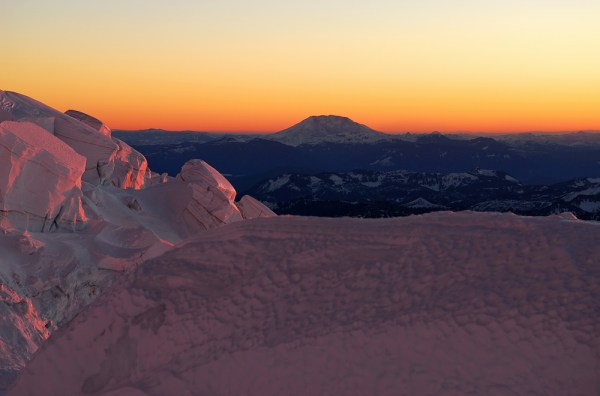
After Mount St. Helens famously erupted in 1980, I didn’t return to ski it until after May 1987. Before then, it was closed to the public due to safety concerns; otherwise, it would’ve been first on my list because it can be the easiest.
As skiers returned to the mountain, the biggest change was the missing 1,314 feet that blew off or slid away to the slopes below. (The crater itself is still permanently closed to anyone but certain scientists and researchers.) While diminished, the mountain is still a worthy prize and the perfect climb-and-ski adventure to kickoff your volcano quest.
During the winter and early spring, most skiers and climbers ascend via the Worm Flows climbing route—it’s the most direct to the summit and while it’s a good challenge, it’s non-technical. Park and start at the plowed Marble Mountain Sno-Park. Be aware of avalanche-prone areas and avoid wandering too close to the crater rim. Snow cornices can hang 20 feet or more over the crater.
Climbing permits and parking permits are required; information can be found on the Mount St. Helens Institute website. Find more information on the Forest Service site.
Mount Adams (Elev.12,277 feet)
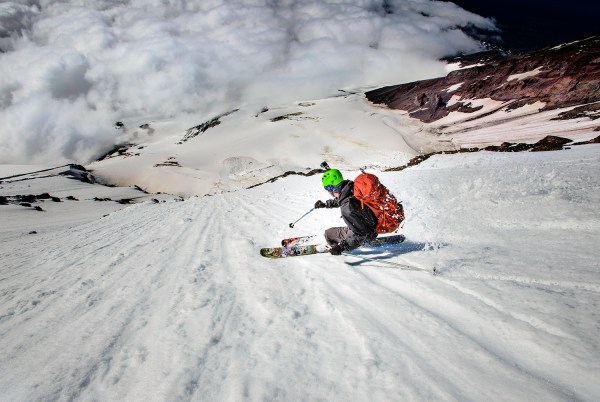
For many Washingtonians, Adams is their first significant climb to altitude. Adams is the second-highest volcano in the state, and it’s the second-easiest to summit. Nevertheless, the altitude can be problematic for those who live at sea level. To mitigate those effects, plan on camping for a night between 7,000 and 10,000 feet. The best time to climb and ski Mount Adams starts usually in May and stretches as late as early July. Plan on 6–8 hours up, and 4–6 hours to descend.
The South Spur, also known as the South Climb, is the most popular route to the summit and by far the easiest, but if you’re up for a challenge there are 13+ skiable routes on the massif. For the South Climb, begin at or near the South Climb Trail #183. The road is usually snowed-in at least a mile or two until late May. Just beyond Piker’s Peak, otherwise known as the false summit, you’ll find a flat area. Many folks leave their skis here since the last portion of the climb regularly has wind-scoured snow. If the weather is deteriorating, this is a smart place to retreat from.
If you find the skiing is beyond your means, the best glissade path in the state usually descends from Pikers Peak 2,000 feet down to Lunch Counter. It’s a fantastic Plan B!
Climbing permits are required and information can be found on the Forest Service website. Some trailheads also require a recreation pass (found here). Between May and September 30th a climbing pass can double as a recreation pass if you are climbing.
Mount Baker: (Elev.10,781 feet)
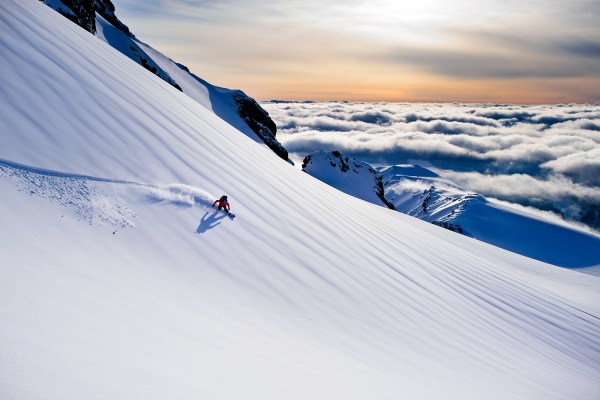
My views of Mount Baker from my dorm at Western Washington University in nearby Bellingham did little to indoctrinate good study habits. After only a few months, when the distractions became too much, I skied Baker over two days from the summit with my dad and brother via the Coleman-Deming route. It would be one of my last big peaks with my dad. From then on, I’d explore the Cascades peaks on my own.
Mount Baker receives an incredible amount of snow. In fact, the Mount Baker Ski Area holds the world record for seasonal snowfall. In the 1998-’99 season, it received 1,140 inches! Due to the prodigious amounts of snow, you can ski on Baker year round with most ski descents happening in May and June.
All routes to the summit of Baker ascend one or more glaciers, so an understanding of glacier travel is crucial. The Coleman–Deming and the Easton Glacier routes are the two most popular for skiing. Baker is often climbed in a day, but I suggest two days if it is your first time on the mountain.
Access is limited in the winter months due to roads being snowed-in most years. Some years access is attainable though. Scour popular websites like Turns All Year or Powder Project for recent trip reports and current conditions. A free permit is available at the main trailheads, but some trailheads also require a recreation pass (found here).
Glacier Peak (Elev. 10,541 feet)
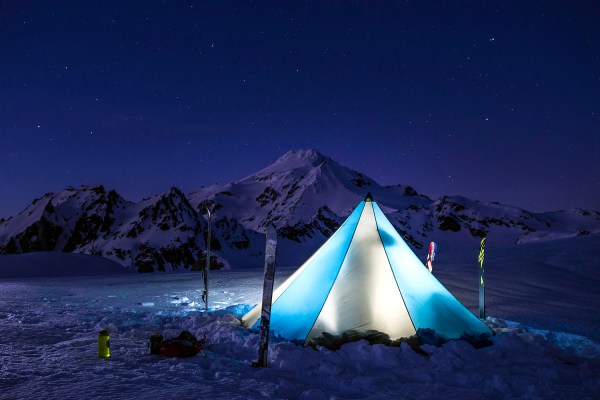
Ever since I was a kid, I’ve always held a special place in my heart for Glacier Peak. She’s the heart of 894 square miles of wilderness that epitomizes what the wilderness experience should be—wild and untrammeled landscapes filled with forests, rivers, lakes and mountains, not to mention an assortment of wildlife from shy bears to voracious mice. This is the most remote of the five volcanoes, and you’ll need to check carefully on road closures and conditions.
The old standard route via the Sitkum Glacier is now defunct due to washouts on the trail and road. Most people now approach via the North Fork Sauk River trailhead. From this trail you can ascend several routes, but most people climb the Cool Glacier via White or Red passes depending on the snowpack, which takes 2–4 days to climb. The most-used camps are at White Pass or the White Chuck Glacier.
Other more adventurous routes can be taken into Glacier Peak via the Dakobed or Painted Traverses. Either route takes 4–7 days and good weather.
The skiing on Glacier Peak is moderate with the steepest slopes on the last few hundred feet to the summit. Typically that top section is wind-scoured and not great for skiing. For a better ski descent, you can add a quick climb and descent of Disappointment Peak. Most people ski Glacier Peak between April and July. The later the time of year, the more walking, which is often through immense flower fields and old-growth forest.
There’s no fee for a climbing pass; it’s the only volcano besides Baker that you can climb for free. You can sign in at the trailhead or ranger station. Some trailheads also require a recreation pass (found here).
Mount Rainier (Elev. 14,411 feet)
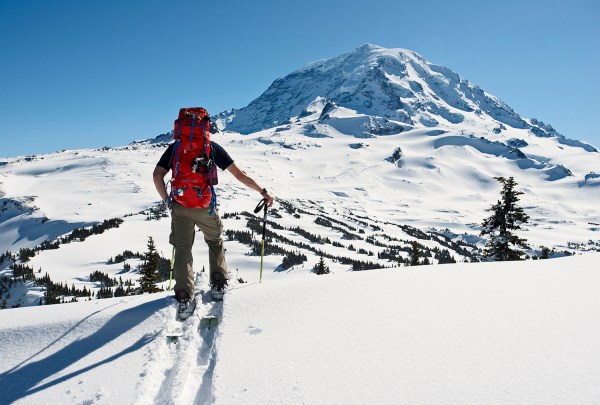
This is the granddaddy of all the volcanoes. The one you’ve been waiting to climb. It’s the most difficult to ski and the most technical. That’s why it is the crowning accomplishment in your volcano boot camp! That being said, by ascending and skiing the four other volcanoes, you’ll have a great primer for what’s ahead.
Mt. Rainier is typically climbed and skied in two days, with very fit and experienced ski mountaineers doing so in a day. If this is your first time on Rainier, I would strongly recommend three days. Of, if your time is limited, climb up to Camp Muir at around 10,000 feet and ski down from there.
Popular ski routes on the mountain vary significantly in difficulty. Ingraham Direct, Emmons Glacier and Disappointment Cleaver are the standard routes on Rainier and very likely the easiest, depending on conditions. Other slightly more difficult routes that are commonly skied are the Fuhrer Finger and Kautz Glacier.
Climbing permits are required. Details are on the NPS website. Camp zones have limited space and do fill up, especially Camp Muir and Camp Schurman.
With skiing and climbing, a good day is when you come home. Skiing from the top or from halfway up the mountain are both fun! Stay within your limits. There is always another day.
There you have it. Now, all you need is extensive research and friends willing to go the extra mile and vertical feet for you.
